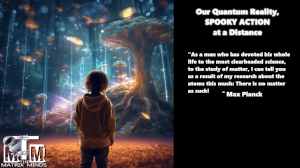 For centuries, philosophers, scientists, and mystics have pondered the nature of reality and the relationship between consciousness and the physical world. Quantum mechanics, the branch of physics that deals with the behavior of particles at the smallest scales, has challenged our conventional understanding of reality. In this article, we will delve into the intriguing concept of reality as a wave, the role of perception in collapsing that wave, and its connection to the enigmatic phenomena of “spooky action at a distance” and human consciousness.
For centuries, philosophers, scientists, and mystics have pondered the nature of reality and the relationship between consciousness and the physical world. Quantum mechanics, the branch of physics that deals with the behavior of particles at the smallest scales, has challenged our conventional understanding of reality. In this article, we will delve into the intriguing concept of reality as a wave, the role of perception in collapsing that wave, and its connection to the enigmatic phenomena of “spooky action at a distance” and human consciousness.
Reality as a Wave
In the quantum world, particles such as electrons and photons can exist in multiple states simultaneously, forming a wave of probabilities known as a wave function. This wave function describes the potential locations and properties of the particle until it is observed or measured. At that moment, the wave function collapses into a single state, a phenomenon known as wave function collapse.
Perception and Wave Collapse
The act of observation or measurement by a conscious observer plays a pivotal role in wave function collapse. According to the Copenhagen interpretation, one of the most widely accepted interpretations of quantum mechanics, reality only takes a definite form when observed. This implies that the observer’s consciousness has a direct influence on the manifestation of physical reality.
The famous thought experiment of Schrödinger’s cat demonstrates this concept. In the experiment, a cat is placed in a box with a radioactive substance that may or may not decay, triggering the release of a poisonous gas. Until the box is opened and observed, the cat exists in a superposition of being both alive and dead. The act of observation by a conscious observer collapses the cat’s wave function into either being alive or dead.
Spooky Action at a Distance
One of the most perplexing aspects of quantum mechanics is the phenomenon known as “spooky action at a distance” or quantum entanglement. Entanglement occurs when two particles become correlated in such a way that the state of one particle instantly affects the state of the other, regardless of the distance between them.
Einstein famously referred to this as “spooky action at a distance” because it seems to defy our classical understanding of cause and effect. However, quantum entanglement has been repeatedly verified through rigorous experiments, leaving scientists baffled and questioning the nature of reality.
Consciousness and Quantum Reality
The connection between consciousness and quantum reality remains a subject of intense debate and exploration. Some theories propose that consciousness itself emerges from the fundamental principles of quantum mechanics, suggesting that our subjective experiences are intricately linked to the quantum nature of the universe.
The renowned physicist Roger Penrose and anesthesiologist Stuart Hameroff put forth the controversial theory of Orchestrated Objective Reduction (Orch-OR).
Orch-OR suggests that consciousness arises from quantum processes occurring within the microtubules, which are structural components of cells found throughout the body, including in the brain. According to this theory, quantum computations within microtubules generate consciousness and contribute to the collapse of wave functions.
While Orch-OR is still a highly speculative hypothesis, it highlights the profound mystery surrounding the relationship between consciousness and the quantum world. Exploring this connection could potentially lead to a deeper understanding of human cognition and the nature of reality itself.
Furthermore, some proponents of consciousness-centric interpretations of quantum mechanics argue that consciousness may have a participatory role in shaping reality. They propose that our conscious awareness and intention can influence the outcome of experiments and observations, extending the idea of wave function collapse beyond mere observation to intentional action.
Critics of such interpretations argue that they verge on the fringes of science, with insufficient empirical evidence to support them. They assert that consciousness is a product of complex brain activity and does not directly influence quantum processes.
Nevertheless, the exploration of consciousness and its relationship to quantum mechanics is an area of active research. Scientists are conducting experiments to investigate the effects of conscious observation and intention on quantum systems, hoping to shed light on the potential role of consciousness in the fundamental fabric of reality.
The mysteries of quantum mechanics continue to challenge our understanding of reality, perception, and consciousness. The notion of reality as a wave, with the observer’s consciousness collapsing that wave, opens up profound questions about the nature of existence and the role of consciousness in shaping our experience of the world.
While the true relationship between consciousness and quantum mechanics remains elusive, the exploration of these concepts offers a fascinating glimpse into the nature of reality itself. By delving into the enigmatic phenomena of “spooky action at a distance” and contemplating the potential influence of consciousness on quantum systems, we embark on a journey to unlock the secrets of the universe and our place within it.
A MIND OPENER ABOUT REALITY FOR YAH!
If you have not seen or had the chance to see the little movie – WHAT THE BLEEP DO WE KNOW I encourage you to take some time and watch it. It may just open your mind to a many different possibilities about said Reality! – QUESTION EVERYTHING – EVEN REALITY!




Leave a Reply
Want to join the discussion?Feel free to contribute!